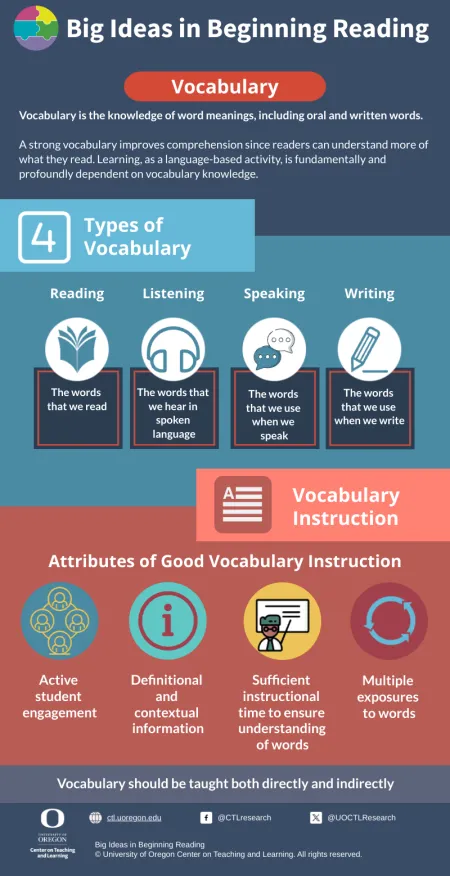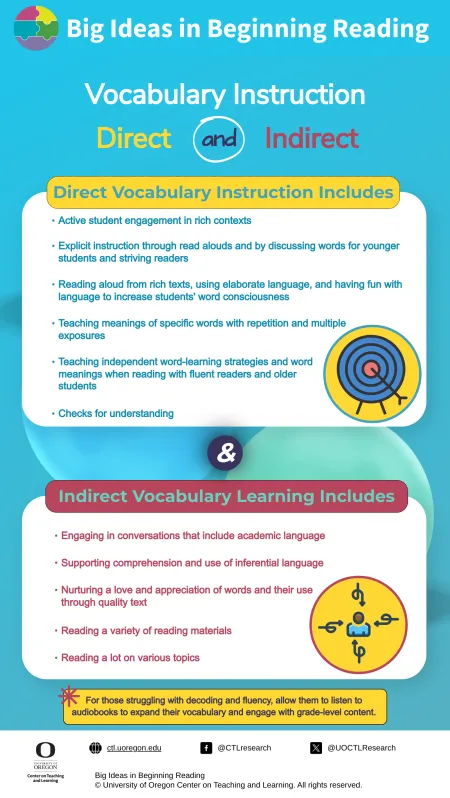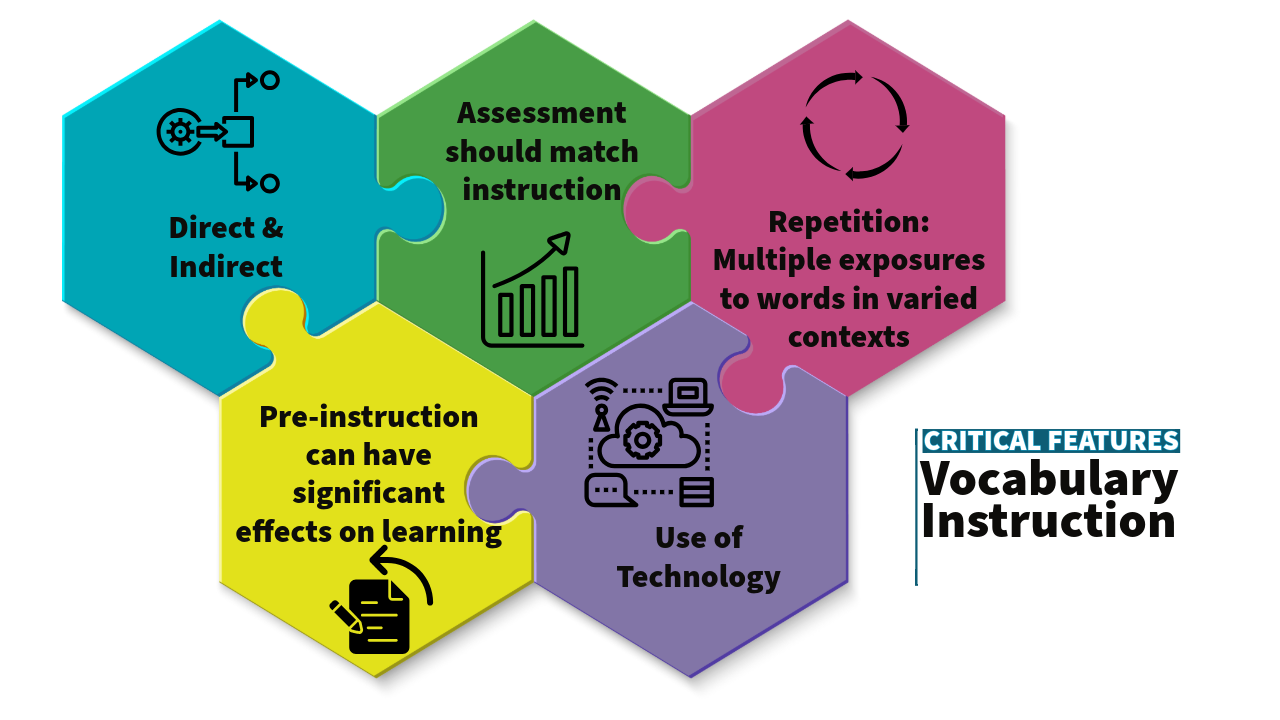The knowledge of word meanings, including oral and written words. A strong vocabulary improves comprehension since readers can understand more of what they read. Learning, as a language-based activity, is fundamentally and profoundly dependent on vocabulary knowledge.
Vocabulary knowledge plays a foundational role in learning to read and understand text. Children build vocabulary both directly through explicit instruction and indirectly through rich conversations, read-alouds, and exposure to new words in meaningful contexts. On this page you will learn about effective vocabulary practices that help students develop word knowledge essential for reading comprehension and academic success. Teachers and families alike can nurture a love and appreciation of words and their use with children.
Overview
Mini Mastery – Vocabulary
What is vocabulary?
Vocabulary is the knowledge of word meanings, including oral and written words. A strong vocabulary improves comprehension as it allows readers to understand more of what they read. Its development starts early, before children learn to read. There are four types of vocabulary:
- Listening Vocabulary - the words that we hear
- Speaking Vocabulary - the words we use when we speak
- Reading Vocabulary - the words that we read
- Writing Vocabulary - the words we use when writing
Differences in vocabulary knowledge are usually due to relative economic advantage, not race, ethnicity, gender, or birth order. The gap between the growth of students with less exposure to rich vocabulary and that of their peers often widens over time. So, it’s essential that vocabulary development is a fundamental goal for all students in the early grades.
Why is vocabulary important?
Vocabulary is essential to comprehension – which is the goal of reading. Learning, as a language-based activity, is dependent on vocabulary knowledge. To learn, students must have access to the meanings of words that teachers use. Not knowing the meaning of a word or not automatically recognizing a word can impair reading comprehension.
Vocabulary is the glue that holds stories, ideas, and content together to make reading comprehension possible for children.
What should vocabulary instruction look like?
Attributes of good vocabulary instruction include:
- Active student engagement
- Definitional and contextual information
- Sufficient instructional time to ensure understanding of words
- Multiple exposures to words
Direct Vocabulary Instruction can be taught at all ages
Children should be explicitly taught the meanings of specific words with repetition and multiple exposures. This should occur in rich contexts with active student engagement in vocabulary learning tasks and provide skills and opportunities to learn words independently.
Teaching vocabulary directly is important since around 70% of the most frequently used words have multiple meanings and can improve reading comprehension for both native English speakers and non-native English learners.
For younger students and striving readers, teach vocabulary explicitly through read alouds and by discussing words directly related to text. Use simple definitions and illustrate with examples. Check for understanding and review.
For fluent and grade-level readers, teach independent word-learning strategies to access word meanings when reading. Let students talk to each other about the words in their reading materials. Use examples, non-examples, synonyms and definitions.
Increase students' word consciousness, or the knowledge that words have meaning, by:
- Reading aloud from rich literature daily.
- Communicating an appreciation and love of words by using elaborate language.
- Drawing attention to the meanings and use of specific words.
- Have fun with words and language by using idioms, analogies, tongue twisters, and rhymes.
Many vocabulary words are learned indirectly through independent reading and by being read to on a variety of topics in books, magazines, and articles. It’s important to provide children with rich vocabulary learning opportunities in and out of school. Teachers and families alike can nurture a love and appreciation of words and their use with children. Choose quality text that children enjoy listening to or reading with you.
For those readers struggling with decoding and fluency, allow them to listen to audiobooks to expand vocabulary and engage with grade-level content. Keep in mind, students with smaller vocabularies are less likely to learn new words from indirect exposure than students with larger vocabularies, so teachers need to provide these students with more explicit vocabulary instruction rather than relying solely on audiobooks.

Download Infographic
Vocabulary Instruction: Direct and Indirect
Direct Vocabulary Instruction Includes
- Active student engagement in rich contexts
- Explicit instruction through read alouds and by discussing words for younger students and striving readers
- Reading aloud from rich texts, using elaborate language, and having fun with language to increase students' word consciousness
- Teaching meanings of specific words with repetition and multiple exposures
- Teaching independent word-learning strategies and word meanings when reading with fluent readers and older students
- Checks for understanding
Indirect Vocabulary Learning Includes
- Engaging in conversations that include academic language
- Supporting comprehension and use of inferential language
- Nurturing a love and appreciation of words and their use through quality text
- Reading a variety of reading materials
- Reading a lot on various topics

Download Infographic
Role in Reading
Vocabulary is a key ingredient for comprehension. When students understand the words they read, they can focus on making meaning from text. Instruction should target high-utility words, provide repeated exposures in different contexts, and teach strategies for learning new words independently. Vocabulary is not just a reading skill—it supports listening, speaking, and writing as well.
Effective vocabulary instruction should be taught across all grade levels, incorporating direct and indirect methods, aligned assessment, repeated exposure in varied contexts, pre-instruction of key terms, and the strategic use of technology.
Critical Features of Vocabulary Instruction

Effective vocabulary instruction includes:
- Direct and Indirect Instruction: Teach words explicitly and provide meaningful, indirect exposure through conversation and rich texts.
- Assessment Aligned with Instruction: Use progress monitoring to check understanding and guide instruction.
- Repetition in Varied Contexts: Expose students to words multiple times in different settings.
- Pre-Instruction for Key Words: Previewing vocabulary before reading can significantly support comprehension.
- Use of Technology: Audiobooks and digital tools can increase word exposure, especially for students who struggle with decoding.
Assessment in Action
Attempts to measure vocabulary over the years have not been successful - meaning that they have not been valid or reliable. See How to Monitor Vocabulary Learning from the Shanahan on Literacy Blog for more information.
The Science of Reading
Research shows that students with stronger vocabularies are better able to understand what they read and learn new concepts. Effective instruction includes both direct teaching of words and indirect exposure through reading, listening, and conversation. Multiple exposures in meaningful contexts and active engagement with language help students deepen their word knowledge and comprehension.
Key Citations and Research
- Five Research-Based Ways to Teach Vocabulary. Retrieved from https://texasldcenter.org/teachers-corner/five-research-based-ways-to-teach-vocabulary/
- Moody, S., Hu, X., Kuo, L.-J., Jouhar, M., Xu, Z., & Lee, S. (2018). Vocabulary Instruction: A Critical Analysis of Theories, Research, and Practice.Education Sciences, 8(4), 180. https://doi.org/10.3390/educsci8040180
- Anderson, R. C., & Nagy, W. E. (1993). The vocabulary conundrum. Center for the Study of Reading Technical Report; no. 570.
- Baker, S. K., Simmons, D. C., & Kameenui, E. J. (1998). Vocabulary acquisition: Research bases. In What reading research tells us about children with diverse learning needs (pp. 183-218). Routledge.
- Beck, I. L., McKeown, M. G., & Kucan, L. (2002). Bringing words to life: Robust vocabulary instruction. Guilford.
- Carlo, M. S., August, D., McLaughlin, B., Snow, C. E., Dressler, C., Lippman, D. N., ... & White, C. E. (2004). Closing the gap: Addressing the vocabulary needs of English‐language learners in bilingual and mainstream classrooms. Reading Research Quarterly, 39(2), 188-215.
- Coyne, M. D., McCoach, D., Loftus, S., Zipoli, R., Ruby, M., Crevecoeur, Y., & Kapp, S. (2010). Direct and extended vocabulary instruction in kindergarten: Investigating transfer effects. Journal of Research on Educational Effectiveness, 3(2), 93-120.
- Dale, E., O'Rourke, J., & Barbe, W. D. (1986). Vocabulary building: A process approach. Zaner-Bloser.
- Diamond, L. & Gutlohn, L. (2006). Vocabulary handbook. Consortium on Reading Excellence, Inc. (CORE).
- Lederer, R. (1991). The miracle of language. Pocket Books.
- National Research Council. (1998). Preventing reading difficulties in young children.
- Rupley, W. H., Logan, J. W., & Nichols, W. D. (1998). Vocabulary instruction in a balanced reading program. The Reading Teacher, 52(4), 336-346.
- Stanovich, K. E. (2009). Matthew effects in reading: Some consequences of individual differences in the acquisition of literacy. Reading Research Quarterly, 21, 360-407.

